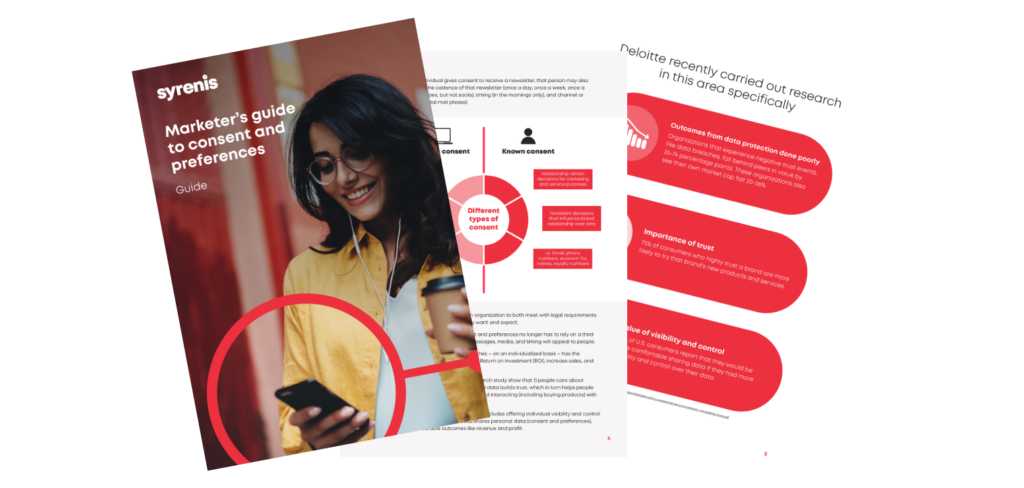According to Forrester, 77% of customers are willing to either recommend or pay more for a brand that provides personalized service/experiences. Similarly, another source states that 71% of consumers expect personalization and 75% get frustrated if their experience is not customized.
Jump to:
- The power of personalization
- When personalization goes too far
- Striking the right balance
- Using predictive personalization techniques
- Ask (But not too much)
The power of personalization
When done right, personalization delivers a host of benefits:
- Higher conversion rates
- Improved revenue
- More efficient marketing spend
- Increased customer satisfaction and loyalty
Customers appreciate experiences that feel tailored, like intuitive website navigation, relevant product recommendations, and communications that feel human and friendly.
That said, there is such a thing as too much of a good thing.
When personalization goes too far
Though the line between personalization done well and personalization done poorly is a thin one, “overpersonalization” is not only possible, but it also can result in a worse experience than if there were no personalization at all.
Done incorrectly, personalization efforts can feel manipulative, overbearing, intrusive, and even scary to consumers. Customers can feel watched and like they have no privacy, which is unpleasantly creepy.
In addition to negative customer reaction to “creepiness,” there are other practical negative outcomes from overpersonalization. One such result of overpersonalization is a boring, homogenous, narrow experience.
For example, if a customer searches for information on wildflower seeds, purchases equipment to plant wildflowers, and has recently joined social media groups targeted to wildflower photographs, a company may display only information related to wildflowers, wildflower planting, and related photos. However, given that human beings are rarely one-dimensional, that customer may become bored with the company’s website and the company may miss an opportunity to provide products related to that customer’s other interests.
This can also lead to cognitive burden associated with personalization, which can tire customers and eventually drive them away. This is because personalization techniques often rely, in part, on asking the user to set preferences related to their experience. However, each time a company asks an individual what exactly they want from their experience, that company places a small cognitive burden on that person. Multiply that burden across multiple choices, and the customer can become exhausted and, eventually, give up and leave altogether.
Striking the right balance
The task in front of each company, then, is to determine where that line between positive personalization and overpersonalization lies. Fortunately, there are also two simple actions a company can take to help ensure that not only that it establishes the right level of personalization, but that the company also mitigates the possible negative impacts of personalization.
Using predictive personalization techniques
Rather than limit personalized experiences to topics or products that the individual in question has directly requested or investigated through online or other behaviors, a company can add in other experiences that research (or intuition) suggests will also interest that individual.
For example, consumers that are interested in skincare may be 3.2 times more likely to also click on links related to ani-aging, and 2.1 times more likely to click on links related to aromatherapy. To help prevent narrow, boring experiences, a company might use this type of predictive analysis to show a consumer interested in skincare these additional topics or products, in addition to skincare products.
Similarly, going back to the theoretical example of a customer interested in wildflowers, a company might also show this customer not only wildflower seeds, but possibly also small farm products, organic foods, and camera lenses, assuming that predictive analysis suggests that the individual may also be interested in those topics too.
Ask (But not too much)
One of the best ways for a company to avoid privacy pitfalls and the “creepy factor” in personalization is to give consumers privacy choices.
Putting control in the user’s hands will allow them to establish the privacy boundaries that are right for them. A customer with a higher tolerance for tracking and personalization can say so. A customer with a lower tolerance for tracking and personalization can also express those wishes, and as a result receive a less customized but more comfortable experience.
There is a difference, however, between allowing a user to set their privacy levels and asking the user to do all the work of declaring exactly what content they see, how often, and how often. The former grants users control over how the company collects and uses personal information and requires only a small amount of effort on the user’s part. The latter can require quite a bit of effort, as the user must describe in detail exactly what topics and other experience elements they prefer. This amount of effort can exhaust the individual and result in a narrow, telescopic set of experiences that bore and eventually drive away that individual.
For example, a company that sells gardening tools might ask its customers whether they want to accept tracking cookies, what their marketing communication preferences are, and whether and how much targeted advertising they want to receive.
For customers that say yes to cookies, emails, and targeted ads, that company has quite a bit of flexibility to customize experiences according to those preferences, while still allowing for breadth of experience and easy customer control.
On the other hand, if that company had asked its customers exactly what content they wanted to see, the company would limit itself to the experiences it provides according to those instructions, and customers would have had to spend a significant amount of time expressing their preferences.
Summary
While personalization offers clear business advantages, poorly executed personalization can actually harm the customer experience more than having none at all. The key is finding the right balance.
To avoid the pitfalls of overpersonalization, companies should expand the scope of their curated experiences using predictive personalization, leveraging known preferences to suggest related interests and content. This approach keeps experiences fresh and engaging without being overly narrow.
Equally important is giving customers control over their privacy settings. Allowing users to set general boundaries, without requiring them to micromanage every aspect of their experience, helps maintain trust, reduces cognitive load, and avoids the “creepy” factor. This balance creates a more flexible, respectful, and effective personalization strategy.


